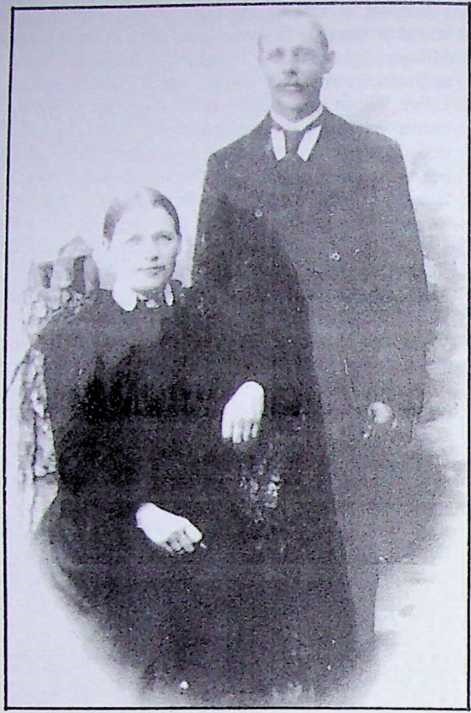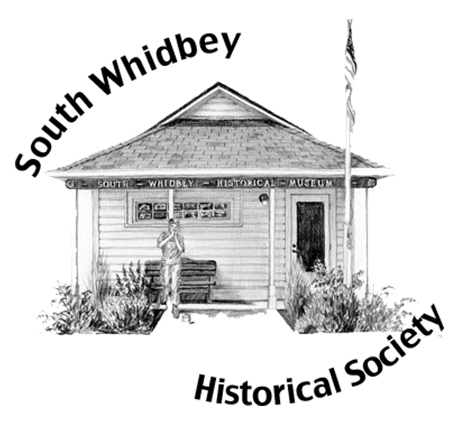
Peter and Pauline Anderson came to South Whidbey by way of Minnesota and Tacoma. They finally settled in Clinton in 1911 with their family.
The year was 1911. It was a beautiful summer morning. Peter Anderson pulled his row-boat beside the Clinton dock, rested his oars on the prow, and observed the bustling little business community on the beach; then, he noted the hill¬side of the plateau on high ground overlooking Clinton. Sizing up the over-all situation, he turned his attention back to the beach.
People were hustling in and out of a general merchandise store. Farther up the shore to the south stood a large white building—apparently a hotel or restaurant. Up the shore northward was a brick kiln that also was humming with activity.
Peter’s ear caught a snatch of conversation between two people coming out of the store. They were speaking Norwegian, Peter’s native tongue. That clinched the matter for him. He had been rowing for days, all the way from Tacoma to Ever¬ett, all around the Everett waterfront, across Sara¬toga Passage to Whidbey Island, and down the coast-line until he finally came to rest beside the dock in Clinton.
Ever since he and his wife Pauline and their children had left Norway in 1906 to seek their for¬tune in the new world, they had been looking for just the right spot to settle down and make a per-manent home. They had spent two years in Min¬nesota and three more in Tacoma where Peter had worked at his trade as a powder-man, skilled in stone work and the use of dynamite. However, he wanted to work with the land and make things grow. Pauline wanted fresh air and open space for the children, not city streets.
Peter beached his boat and made a tour of the town. The more he saw, the better he liked it. Eventually he met Tom Orr and purchased a plot of land from him on what is now Anderson Road (which was named for him). Before moving his family onto his new property, he built a house with one large room downstairs and another up¬stairs. Their immediate neighbors were the Jacob Simmons and Tom Orr families. Andrew Orvick was their first mail carrier, followed later by Ed Thorsen and then Gust Erikson.
At the time Peter and Pauline left Norway, they had six children; Esther, who was later to become Mrs. Ted Simmons, Oscar, Gustave, Mag¬nus, William, and Hoken. Their son Paul, was born during their stay in Tacoma. Their youngest daughter Ruth was born after they settled in Clin¬ton and she has remained in the community. She married Leif Heggenes and their children and grandchildren have been prominent in South Whidbey Island activities up to the present time, 1985. Lloyd Heggenes married Vivian Sandi; their children are Heidi, Brian, and Susie. Roy Hegg¬enes, a South Whidbey Island building contractor, married Joyce Green; their children are Bonnie, Donald, and Sandy. Alfred Heggenes married Mary Jane Chadwick; their children are Mark, Bobby, and Stacy. Michael Heggenes, popularly known as “Mick” to South Whidbey Island sports fans, became the high school athletic coach. He married Christy Pischel; their children are Jason, Joshua, Jacob, and Amy. Norman Heggenes mar¬ried Cathy Olson and moved to Sequim where he became a school principal. They have three children.
At the time of Ruth’s birth, the Anderson family was just getting settled in Clinton. With ten in the family (including the new baby), there was work to do, so Esther, then 17, took on much of the house work. As the baby Ruth grew older, Es¬ther augmented the family income by doing house-work for various neighbors including the Orrs, the Chris Bergs, the Dallas Salisburys, Doc¬tor Frick, and the Cunninghams.
For a while, Peter Axiderson worked for Tom Orr digging ditches and clearing land for a dollar a day—considered to be good wages at that time. He also devised a special stump-pulling machine with a long cable. When her brothers were not around, Esther would help her father operate the device. After stumps were uprooted, they were burned. Many long evenings were spent around stump fires. All the Anderson sons helped with land clearing and work on the farm until they were in their teens. Some of them went to Everett where they worked in a box factory.

The photograph above was taken in 1922, probably from the roof of the adjacent Clinton dock. The shingle mill is in the foreground. In the background from left to right is a white house, originally the hotel and home of Jonathan Salisbury.
Life was not all work and no play. The Clinton Progressive Hall was a regular bee-hive of enter-tainment. There were square dances with music provided by local talent. There was a variety of games for young people including, for a time, roll¬er skating which was great fun but almost wore out the floor. Sunday buggy rides were a real treat. So was watching boats dock and unload on long Sunday afternoons.
The Andersons owned a beach lot near the present ferry slip. They often carried a picnic basket down the hill for a beach party, occasion¬ally purchasing a big salmon for 50c from a fisher¬man. For some time after he settled in Clinton, Peter Anderson had no horses. Finally he bought an old retired race horse which turned out to be so balky that no one could handle it except Magnus. Unfortunately, one day when they were trying to get the horse to cross a bridge near the beach, the horse fell off the bridge and had to be shot.
When Peter Anderson arrived in Clinton, one of the first people he met was Tom Orr, from whom he bought property. The story of how Tom Orr came to Clinton and became the owner of a large tract of land follows.
